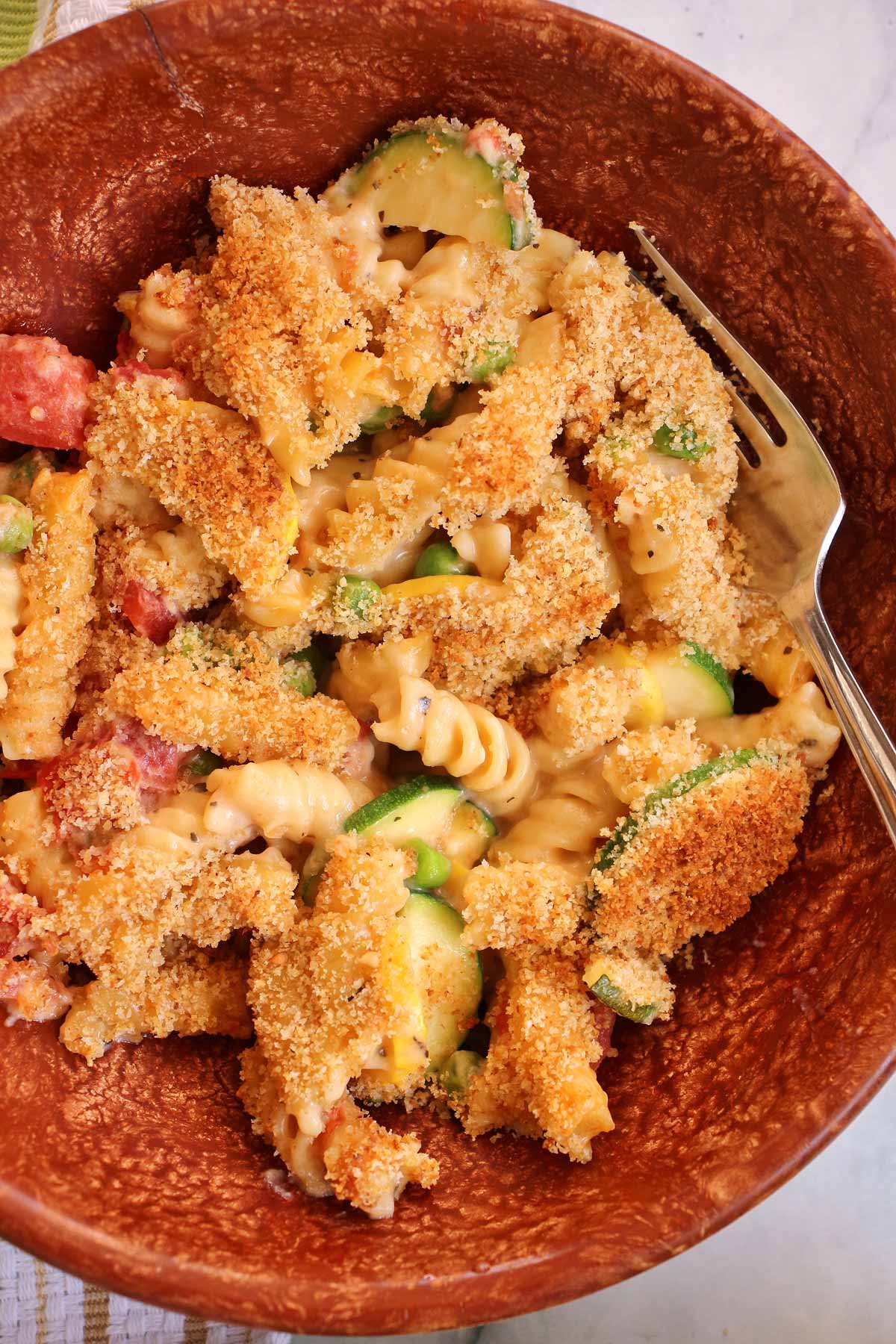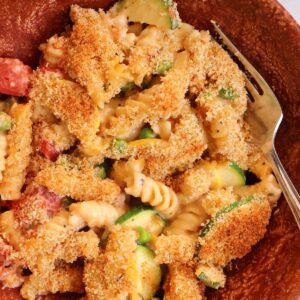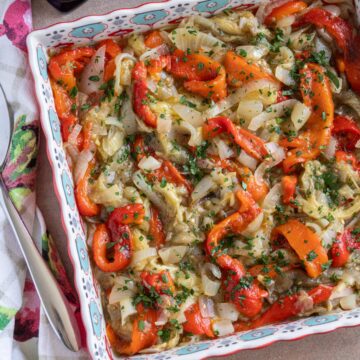This easy healthy mac and cheese with veggies incorporates zucchini, peas, and tomatoes to create a colorful low-guilt indulgence. It has tons of flavor but less calories with the addition of skim milk and reduced fat cheddar cheese. This veggie mac and cheese truly strikes a balance between classic comfort and lighter fare.

(This recipe was originally published in July 2013, but was updated with new photos and content in 2020).
I have been making this healthier veggie mac and cheese for many years. There’s no hidden veggies here. They’re in full view, providing gorgeous color and texture to this cozy classic.
The mixture of zucchini, yellow summer squash, peas, and tomatoes creates a nice balance of veggies that are nearly as plentiful as the pasta itself.
Meanwhile, the amount of cheese sauce for this mac and cheese primavera is a bit restrained. The veggies will release some water as they cook which will lend more liquid to the sauce. It ends up being just the right amount of sauce to cling to all the pasta and veggies and bake into a perfectly bubbly casserole.
Ingredient notes

- Macaroni: Use a short pasta shape like rotini or cavatappi/cellentani. If you want a bit more fiber in your veggie mac and cheese, you can also make this recipe with whole wheat pasta.
- Cheddar Cheese: This healthier mac and cheese uses reduced fat cheddar cheese. Grating your own cheese is always best practice, but pre-shredded cheese will work if that’s all you can get. You can use full fat cheese if you desire, but it will obviously add more fat and calories to the provided nutritional information.
- Milk: Use skim or low-fat milk to save calories. Either will thicken up very nicely in this recipe.
- Zucchini & Summer Squash: You could use just one or the other, but using both zucchini and summer squash adds not one but two colors to this mac and cheese primavera. You’ll need a total of 12 ounces, so aim for one small of each thinly sliced into half moons.
- Peas: Frozen peas are easily accessible and great for this recipe. You can use fresh peas too, but those are super seasonal.
- Diced Tomatoes: I recommend using drained canned diced tomatoes for this recipe. I have tried making it with fresh tomatoes and it’s just not the same, as fresh tomatoes are usually more watery. The diced tomatoes will retain their shape and provide perfect bites of tomato throughout your veggie mac and cheese.
How to make it
Lightly grease a 13-by-9-inch (or 3 quart) baking dish and set aside.
In a large pot of boiling salted water, cook the pasta for about half as long as the box suggests for al dente. It will continue to cook in the oven. Drain and set aside.
In a large pot over medium heat, melt 3 tablespoons of the butter and then whisk in the flour to make a roux (PHOTO 1). Add the hot milk slowly, whisking continuously, until it creates a smooth sauce (PHOTO 2).
Bring the sauce to a simmer, still whisking so it doesn’t burn, and allow it to slightly thicken for a few minutes. It should coat the back of a spoon (PHOTO 3). Remove the sauce from the heat and add the salt, garlic powder, and Italian seasoning (PHOTO 4).

Then stir in the cheese until it is completely melted (PHOTOS 5-6). Add the vegetables and cooked pasta and stir to coat (PHOTOS 7-8).

Pour the mixture into the prepared baking dish and spread it out evenly (PHOTO 9). Melt the remaining tablespoon of butter and stir it into the bread crumbs. Top the macaroni and cheese with the bread crumbs (PHOTO 10).

Bake until bubbly around the edges. Switch to the broiler and broil for another couple minutes, or until the top begins to brown (PHOTO 11). Serve immediately (PHOTO 12).

Please scroll to the bottom of the post for the full recipe (in a printable recipe card) including ingredient amounts and detailed instructions.
Expert tips and FAQ
This recipe yields 8 servings, however it can yield 6 slightly larger, more generous servings.
Alternatively, bake this veggie mac and cheese in smaller baking dishes adding up to about 3 quarts volume. I often bake a medium sized casserole (about half the volume size the recipe calls for) and then divide up the remainder of the macaroni/veggie mixture into smaller oven-safe dishes. Then I tightly wrap the smaller dishes first with plastic wrap, then with foil, and freeze them for future one-off meals. I freeze them unbaked and bake them fresh when I am ready to eat them.
In the photographs in this post I use a Le Creuset 10 ½-by-7-inch (1.75 quart) baking dish, a Le Creuset 7-by-5-inch (16 ounce) baking dish, and a couple oven-proof bowls I usually use for French onion soup. I baked the largest dish and froze the other three.

To cook previously frozen mac and cheese, first defrost in the refrigerator overnight. I don't usually bake from a frozen state as I find it bakes unevenly and takes a long time to heat all the way through to the center. Bake the thawed mac and cheese as instructed above. It will take a bit longer to bake a cold casserole right out of the fridge than a warm one you've just assembled.
Store-bought shredded cheeses contain preservatives and anti-caking agents. These can impact the flavor and melting quality of the cheese. Grating cheese yourself avoids these additives and will result in optimal flavor and texture.

Other recipes you may like
- Classic Baked Macaroni and Cheese
- Homemade Stovetop Mac and Cheese
- Kid Friendly Mac and Cheese
- Baked Pasta Bianca with Five Cheeses
- Älplermagronen (Swiss Alpine Macaroni and Cheese)
- Tuna Noodle Casserole (From Scratch)
- Pasta e Piselli (Pasta and Peas)
- Pasta al Forno with Roasted Vegetables
Tried this recipe? Please leave a star ⭐️⭐️⭐️⭐️⭐️ rating in the recipe card below and/or a review in the comments section further down the page. You can also follow me on social media on Facebook, Instagram, and Pinterest!

Veggie Mac and Cheese Primavera
Ingredients
- 1 pound short pasta such as rotini
- 4 tablespoons unsalted butter divided
- ¼ cup all-purpose flour
- 3 cups skim or low-fat milk heated to a simmer
- 1 ½ teaspoons kosher salt
- 1 ½ teaspoons garlic powder
- ¾ teaspoon dried basil
- ¾ teaspoon dried oregano
- 8 ounces reduced fat cheddar cheese grated
- 12 ounces zucchini and summer squash (one small of each), halved lengthwise and thinly sliced ⅛-inch thick
- 1 (14.5-ounce) can diced tomatoes, drained (plain or Italian-style work equally well)
- ¾ cup peas (fresh or frozen)
- ¾ cup bread crumbs (fresh or dried)
Instructions
- Preheat the oven to 350°F. Lightly grease a 13-by-9-inch (3 quart) baking dish and set aside.
- In a large pot of boiling salted water, cook the pasta for about half as long as the box suggests for al dente. Drain and set aside.
- In a large pot over medium heat, melt 3 tablespoons of the butter and then whisk in the flour. Add the hot milk slowly, whisking continuously, until it creates a smooth sauce. Bring the sauce to a simmer, still whisking so it doesn’t burn, and allow it to slightly thicken for a few minutes. It should coat the back of a spoon.
- Remove the sauce from the heat and add the salt, garlic powder, and Italian seasoning. Then stir in the cheese until it is completely melted. Add the vegetables and cooked pasta and stir to coat. Pour the mixture into the prepared baking dish and spread it out evenly.
- Melt the remaining 1 tablespoon of butter and stir it into the bread crumbs. Top the macaroni and cheese with the bread crumbs and then bake for about 20 to 25 minutes until bubbly at the edges. Switch to the broiler and broil for another couple minutes, or until the top begins to brown. Serve immediately.
Notes
- This recipe yields 8 servings, however it can yield 6 slightly larger/more generous servings each with 604 calories, 82 g carbs, 28 g protein, 18 g fat, 52 mg cholesterol, 6 g fiber, 7 g sugar.
- Alternatively, bake this veggie mac and cheese in smaller baking dishes adding up to about 3 quarts volume. I usually like to bake a medium sized casserole (about half the size the recipe calls for) and then divide up the remainder of the macaroni/veggie mixture into smaller oven-safe dishes. Then I tightly wrap the smaller dishes first with plastic wrap, then with foil, and freeze them for future one-off meals. I freeze them unbaked and bake them fresh when I am ready to eat them.
- To cook previously frozen mac and cheese, first defrost in the refrigerator overnight. I don't usually bake from a frozen state as I find it bakes unevenly and takes a long time to heat all the way through to the center. Bake the thawed mac and cheese as instructed above. It will take a bit longer to bake a cold casserole right out of the fridge than a warm one you've just assembled.
- This recipe uses kosher salt (aka cooking salt, kitchen salt, coarse salt outside of the US). If you are using table salt, definitely scale down the salt as that is a saltier type of salt! The type of salt will make a big difference in how salty your food tastes, so keep that in mind.
Nutrition
*All nutritional information is based on third-party calculations and should be considered estimates. Actual nutritional content will vary with brands used, measuring methods, portion sizes and more.*








Comments
No Comments